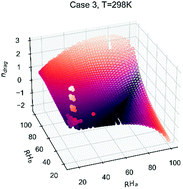Random pore-network model for polymer electrolyte membranes
Abstract
A random pore-network model for polymer electrolyte membranes (PEM) is presented that couples the flow of protons and water through cylindrical channels to the swelling of the membrane. While the flows are determined by closed-form solutions of the Poisson–Nernst–Planck–Stokes equations, the fluid–structure interaction is described by a pressure balance at the channel walls. Macroscopic membrane properties, such as the conductivity, permeability and electro-osmotic coefficient, are computed and compared to experimental data in the literature. In light of the model simplifications, the results compare favourably to data but they also point to the importance of describing proton diffusion in PEM nanopores accurately.



 Please wait while we load your content...
Please wait while we load your content...